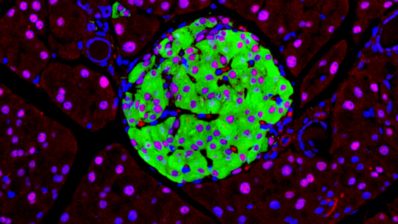Thanks to a combination of mouse and zebrafish models and human organoids, researchers at the Centre for Genomic Regulation (CRG), IDIBELL and the University of Barcelona have uncovered the critical role of the REST gene to boost the number of insulin-producing cells during the early development of the pancreas in mouse and zebrafish.
In this picture of postnatal pancreatic ducts, from the Regulatory Genomics and Diabetes lab led by Jorgue Ferrer, we can see the experiment where the authors inactivated REST and used different labelled antibodies to detect different types of pancreatic cells. In particular, antibodies directed against cytokeratin 19 (green) were used to visualize duct cells, insulin (turquoise) for β cells, and RFP (red) for ducts and some peripheral islet δ cells. In blue, we can see the nuclei of all cells.
They found that the RE1 Silencing Transcription Factor gene (REST) was expressed in embryonic pancreatic cells and in adult cells which form the pancreatic duct, but not in the adult beta-cells that produce insulin. When inhibiting REST expression in mice and fish early on, before the pancreas was formed, the adult animals had double the number of insulin-producing beta-cells. This did not occur if the inhibition was after pancreas formation. This proves that REST is a suppressor of endocrine differentiation.
Interestingly, however, inhibiting REST in human pancreatic organoids did not lead to beta-cell formation, although it increased activity of endocrine genes. This demonstrates that REST is not the only player in endocrine differentiation and beta-cell formation. However, “if one day we come up with a future cocktail of drugs to boost insulin-producing cells in the pancreas, I suspect that REST inhibitors would be part of the recipe”, says Ferrer, senior author of the study.
Want to see your photo here? Send us your images related to science or life at the PRBB to ellipse@prbb.org.
Rovira et al. REST is a major negative regulator of endocrine differentiation during pancreas organogenesis. Published in Advance August 12, 2021, doi:10.1101/gad.348501.121Genes & Dev. 2021.© 2021 Rovira et al.; Published by Cold Spring Harbor Laboratory Press






